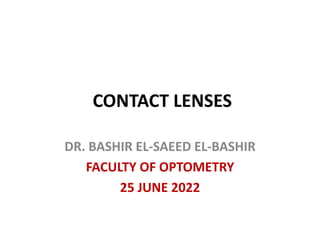
contact_lens_solutions.pptx
- 1. CONTACT LENSES DR. BASHIR EL-SAEED EL-BASHIR FACULTY OF OPTOMETRY 25 JUNE 2022
- 2. SOLUTIONS AND ACCESSORIES • Many solutions and accessories are used in fitting, wearing, and maintenance of contact lenses. • Understanding of these solutions is required by practitioner and assistant. • Problems from mild discomfort to severe ocular damage can occur if the systems are not properly used. • Proper patient education and instruction avoid adverse effects.
- 3. General principles of contact lens solution pharmacology • Tonicity (osmolality): • When the cornea bathed in a solution that has a salt concentration of about 0.9% to 1.0% the cornea will maintain its normal thickness, such solution is called isotonic. • If the salt is less than this, it is called hypotonic. If the cornea bathed on this, water will flow from the solution into the cornea, causing corneal swelling( e.g. when swimming in fresh water( causing cloudy or hazy vision).
- 4. • Excessive tearing (crying or tearing caused by uncomfortable lens)cause some corneal swelling. • Using distilled( water from which salts and other materials have been removed) or plain tap water, the water will flow causing osmotic pressure. Thus, the lens is tightly adhere to the cornea. • Hypertonic solution( salt concentration over 1.0%) causes corneal thinning. Thus solution is for treatment of corneal oedema( caused by ocular disease).
- 5. HYDROGEN ION CONCENTRATION(PH) • The pH of tears is very close to that of the blood , which is 7.3 to 7.4. • Studies have shown considerable variation in human tears, ranging from 5.2 to 8.35 with the majority at 7.0 to 7.4 . • If the pH more than 1to 2 pH units patient may complain of discomfort.
- 6. VISCOSITY (THICKENING AGENTS) • compounds that increase the viscosity are often added to solutions to maintain it on the eye or the lens for longer time. • They act as lubricating and cushioning agent on placement of a contact lens and also help to prevention of contamination through handling prior to placement. • Methyl cellulose is the most common used to increase viscosity. • Others examples hydroxyethyl, hydroxypropyl cellulose, povidone, and gelatin.
- 7. PRESERVATIVES • Any solution that instilled on the eye or used with contact lenses should be free of living organisms, including bacteria, viruses amoebae, and fungi, which might cause an infection. • Sterile solution is free of living organisms. • Benzalkonium chloride is used as preservative in contact lens solutions in concentrations of 0.001% to 0.01%. • Others chorobutol, thimerosal (sodium ethyl mercurithiosalicylate).
- 8. SHELF LIFE • Many solutions containers have an expiration date. • The reason for this is that most chemical compounds tend to break down and change with time. • The preservative may break down and not be effective against bacteria. • Buffering compound may be ineffective, allowing the pH of the solution to change significantly. • The breakup products may become irritant to the eye, causing discomfort, some solutions will turn colour owing to break down of some of the chemicals, commonly a yellow or brown. • Do not used expired solutions.
- 9. TYPE OF SOLUTIONS • Hard contact lens solutions. • Wetting solutions • Soaking. • Storage containers • Cleaning solutions • Combination solutions
- 10. Solutions for use with hydrogel contact lenses • Unpreserved saline solution.(saline solution is made up of 0.9% sodium chloride in distilled water). • Preserved saline solution • Chemical (cold) disinfection • Hydrogen peroxide disinfection. • Cleaning • Heat ( thermal disinfection). • All in one solutions
- 11. ACCESSORY SOLUTIONS • Irrigating solutions: are used to wash foreign bodies and chemicals and moisten fluorescein strips. • PH 7.0 to 7.5 supplied in bottles that can be used to spray a constant stream of solution onto the eye. • Stains: • Fluorescein • Rose Bengal.